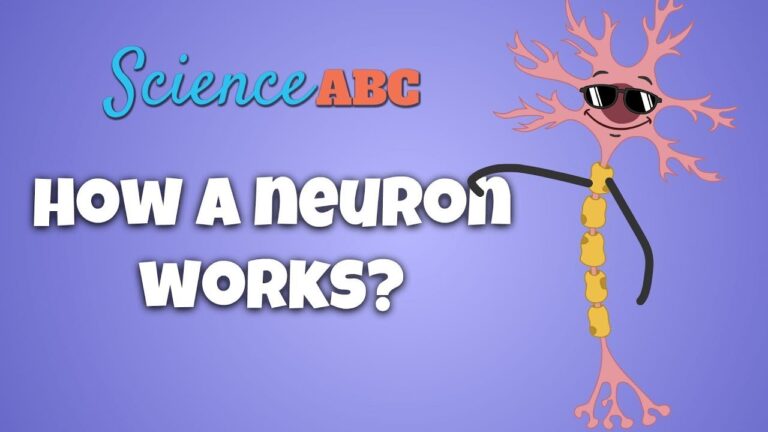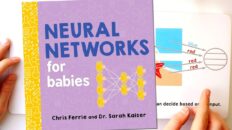The human brain is a sophisticated assembly of Neurons, the fundamental units responsible for transmitting and processing information from our senses. These neurons are intricately interconnected, forming a vast neural network within the brain. They are specialized cells designed to transmit electrical signals, or impulses, from one to another. This transfer of excitation occurs through a structured process. Nerve cells, or neurons, collaborate in intricate patterns to facilitate the transmission of these impulses.
The comparison between Neurons and their Transmission in the human brain, CPUs, and neural networks offers a profound insight into the fundamental processes that drive information processing, cognition, and artificial intelligence. This comprehensive exploration delves into the intricate details of each system while highlighting their remarkable functional equivalences.
Learn How a Neuron Works in the Following Science ABC Video
Neurons in the Human Brain:
Neurons, often referred to as nerve cells, are the essential building blocks of the human brain’s information processing machinery. These specialized cells enable communication within the brain and facilitate various cognitive functions, ranging from sensory perception to complex thought processes.
Neurons in the Human Brain:
Neurons, often referred to as nerve cells, are the essential building blocks of the human brain’s information processing machinery. These specialized cells enable communication within the brain and facilitate various cognitive functions, ranging from sensory perception to complex thought processes.
Neuronal Transmission Process:
- Impulse Reception: Dendrites receive incoming electrical impulses from synapses of neighboring neurons. These impulses carry encoded information.
- CPU Equivalent: Receiving Input Data
- Neural Network Equivalent: Receiving Input Features
- Signal Integration and Processing: The soma integrates incoming impulses and determines the overall strength of the neuron’s response. This process involves summation and thresholding.
- CPU Equivalent: Processing Data and Instructions
- Neural Network Equivalent: Weighted Summation and Activation Function
- Signal Transmission: Once the integration process is complete, the processed signal is transmitted along the axon in the form of an electrical impulse.
- CPU Equivalent: Data Transmission
- Neural Network Equivalent: Propagation of Signal through Layers
- Synaptic Transmission: The synapse facilitates the transfer of the electrical impulse to the dendrites of the receiving neuron. This transfer occurs through the release of neurotransmitters.
- CPU Equivalent: Data Transfer Mechanism
- Neural Network Equivalent: Activation of Nodes and Signal Propagation
Learn How Neurons Communicate in the Following Brain Facts Video
Neuron Structure and Components and Comparison to CPU and ANN
Neurons vs. CPU:
Dendrites – Input Ports: Dendrites in neurons act like input ports in a CPU. Just as dendrites receive incoming signals from other neurons, input ports on a CPU receive data and instructions from external sources, such as memory or peripheral devices. Both dendrites and input ports are responsible for gathering external information and passing it into the processing unit.
Soma/Nucleus – Central Processing Unit (CPU): The soma, or cell body, integrates incoming signals and makes decisions about whether to initiate a response. This function parallels the CPU’s role in processing data and executing instructions. The CPU performs complex calculations, logic operations, and control tasks, akin to the integration and decision-making occurring in the soma.
Axon – Data Bus: The axon’s function of transmitting signals away from the soma finds equivalence in the data bus of a CPU. Just as the axon carries signals to other neurons, the data bus connects different components of a CPU, allowing efficient communication between various parts of the system.
Synapse – Communication Channels: Synapses, where neurotransmitters bridge the gap between neurons, can be likened to communication channels within a CPU. Just as synapses enable signal transmission, communication channels facilitate the transfer of data and control information between different parts of a CPU. Both mechanisms ensure seamless and reliable information flow.
Neurons vs. Neural Networks:
Dendrites – Input Nodes: In the context of neural networks, dendrites align with input nodes. Like dendrites receiving signals in neurons, input nodes in neural networks process and forward input features to subsequent layers for further computation. Both dendrites and input nodes are responsible for receiving and channeling data for subsequent processing.
Soma/Nucleus – Weighted Summation and Activation: The integration and decision-making role of the soma in neurons has a functional equivalent in the weighted summation and activation function performed by nodes in neural networks. Just as the soma integrates signals to determine whether a neuron will fire, nodes in neural networks perform weighted summation of input features and apply an activation function to determine their response.
Axon – Signal Propagation Through Network Layers: The axon’s function of transmitting signals corresponds to the propagation of data through layers in a neural network. As the axon carries signals away from the soma, data is propagated from one layer to the next in a neural network. Both mechanisms ensure the flow of information to enable further processing.
Synapse – Node Activation and Signal Propagation: Synaptic transmission and node activation in neural networks share similarities. Synapses enable the transfer of signals from one neuron to another, while node activation in neural networks determines whether a node’s output will be propagated to the next layer. Both processes involve signal transfer and contribute to the overall information processing.
3. Neural Transmission vs. CPU Operations:
Neural Transmission – CPU Operations: Neural transmission involves the passage of electrical impulses and neurotransmitters to facilitate signal transmission between neurons. In contrast, CPU operations encompass binary electrical signals and logical operations performed by components like logic gates. Both processes are essential for information flow, decision-making, and communication within their respective systems.
4. Neural Transmission vs. Neural Network Propagation:
Neural Transmission – Neural Network Propagation: The precise timing of neurotransmitter release and the activation of nodes in neural networks share similarities. In neural transmission, neurotransmitters are released to bridge the synaptic gap and facilitate signal transfer. In neural networks, nodes are activated based on weighted summation and activation functions, propagating signals through the network.
In conclusion, the functional equivalences drawn between neurons, CPUs, and neural networks shed light on the remarkable convergence of biological and artificial systems. While these comparisons provide a conceptual bridge, it’s essential to recognize that the brain’s complexity, plasticity, and consciousness far surpass the capabilities of current technology. Nonetheless, these parallels fuel our quest for understanding and innovation, driving advancements in both neuroscience and artificial intelligence.
Summary of Functional Equivalence of Neurons, CPUs, and Neural Networks:
Neurons vs. CPU:
- Both neurons and CPUs serve as the primary processing units in their respective systems.
- Dendrites in neurons and input ports in CPUs are analogous in their roles of receiving incoming signals.
- The soma’s integration of signals mirrors the CPU’s processing of data and instructions.
- The axon’s role in transmitting signals finds equivalence in the CPU’s data bus, which connects various components.
- Synapses’ communication channels align conceptually with the various data pathways and communication mechanisms in a CPU.
Neurons vs. Neural Networks:
- Neurons and nodes in neural networks both process and transmit information.
- The role of dendrites in neurons is akin to the function of input nodes in neural networks, as both receive and transmit data.
- The soma’s integration of signals closely resembles the weighted summation and activation function of nodes in neural networks.
- The axon’s transmission of signals can be likened to the propagation of data through network layers.
- Synaptic transmission finds equivalence in the activation of nodes in neural networks, as both processes involve the transfer of signals.
Neural Transmission vs. CPU Operations:
- Neural transmission involves the passage of electrical impulses and the release of neurotransmitters to facilitate signal transfer.
- CPU operations entail the manipulation of binary electrical signals and logical operations through components like logic gates.
- In both systems, information flow, decision-making, and communication are central to their functionality.
Neural Transmission vs. Neural Network Propagation:
- Neural transmission’s precise timing and neurotransmitter release align with neural network propagation, where weighted calculations and activation functions determine signal propagation.
- Both mechanisms contribute to the efficient transmission of signals and the processing of information within their respective contexts.
Conclusion:
In essence, the functional equivalence between neurons, CPUs, and neural networks underscores the remarkable convergence of biological systems and artificial constructs. While the intricacies and adaptability of neurons far surpass current technology, these comparisons highlight the remarkable progress made in understanding and simulating cognitive processes. As we continue to explore the depths of neuroscience and artificial intelligence, these parallels serve as a testament to the human quest for knowledge and innovation.

